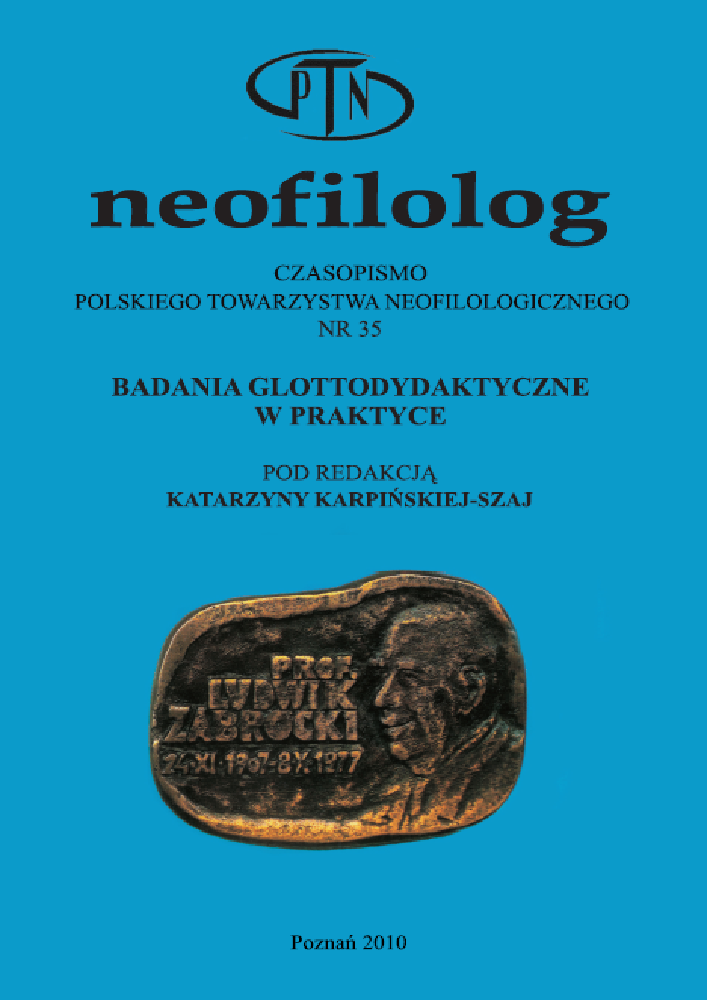Abstrakt
The author investigates the presence of reading models in L2 teaching theory and research. She observes that such models seem to play a rather „ornamental” role. The author is convinced, however, that effective use
of reading models would bring positive results, such as facilitating communication between researchers, and more effective planning of research and teaching. The model that might be taken into consideration is that
developed by the Quebecois pedagogue J. Giasson.
Bibliografia
Acuna, T. 2005. “Le passage des processus de bas niveau aux processus de haut niveau dans l’élaboration d’une représentation du texte“. Acquisition et Interaction en Langue Etrangère. La lecture en langue étrangère. http://aile.revues.org/document356.html DW 14.10.2009.
Alderson, J.C. 2000. Assessing Reading. Cambridge: Cambridge University Press.
Bentolila, A., Chevalier, B., Falcoz-Vigne, D. 1991. La lecture: apprentissage, évaluation, perfectionnement. Paris: Nathan.
Boyer J.Y., J.P. Dionne, P. Raymond, 1993. „Profils de lecteurs de différents niveaux de compétence en fonction des caractéristiques du texte lu” (w) L’Hétérogénéité des apprenants: un défi pour la classe de français. Actes du 5e colloque international de didactique du français langue maternelle (red. M. Lebrun i M.-C. Paret). Neuchâtel-Paris: Delachaux et Niestlé.
Dakowska, M. 2003. Current controversies in foreign language didactics. Warszawa: Wydawnictwa Uniwersytetu Warszawskiego.
van Dijk T.A., Kintsch W., 1983. Strategies of Discourse Comprehension. New York: Academic Press.
Frier C., F. Grossmann, J.P. Simon, 1994. „Lecture et construction du sens: évaluation de la compréhension de textes spécialisés par des étudiants de première année de DEUG”. LIDIL 10: 149-178.
Giasson, J. 1990. La compréhension en lecture. Québec: Gaëtan Morin.
Gough, P.B. 1972. „One second of reading” (w) Language by ear and by eye (red. J.F. Kavanagh i I.G. Mattingly). Cambridge, MA: MIT Press.
Grabe W., F. Stoller, 2002. Teaching and Researching Reading. Harlow: Pearson Education.
Hill C., K. Parry, 1992. „The Test at the Gate: Models of Literacy in Reading Assessment”. TESOL Quarterly 26(3): 433-461.
Karpińska-Szaj K., 2005. Pédagogie de la lecture en langue étrangère. Défis rééducatifs. Poznań: Wydawnictwo Naukowe UAM.
Kintsch, W. 1998. Comprehension. A Paradigm for Cognition. Cambridge: Cambridge University Press.
Kintsch W., T. A. van Dijk, 1978. „Toward a model of text comprehension and production”. Psychological Review, 85: 363-394.
Kurcz I., A. Polkowska, 1990. Interakcyjne i autonomiczne przetwarzanie informacji językowych. Na przykładzie rozumienia tekstu czytanego na głos. Wrocław: Ossolineum.
Meyer, B.J.F. 1975. The organization of prose and its effects on memory. Amsterdam: North Holland.
Piasecka, L. 2008. Psycholinguistic and socio-cultural perspectives on native and foreign language reading. Opole: Wydawnictwo Uniwersytetu Opolskiego.
Rumelhart, D.E. 1977. „Toward an interactive model of reading” (w) Attention and performance VI (red. S. Dornic). Hillsdale, NJ: Erlbaum.
Schmitt, N. 2002. An Introduction to Applied Linguistics. London: Arnold.
Stanovich, K. E. 2000. Progress in understandigng reading. Scientific Foundations and New Frontiers. New York, London: The Guilford Press.
Zagar, D. 1992. „Accès au lexique et calcul syntaxique” (w) Psychologie cognitive de la lecture (red. M. Fayol, J.E. Gombert, L. Sprenger-Charolles, D. Zagar). Paris: Presses Universitaires de France.
Licencja
Prawa autorskie (c) 2010 Agnieszka Kulczyńska

Utwór dostępny jest na licencji Creative Commons Uznanie autorstwa – Bez utworów zależnych 4.0 Międzynarodowe.
Przedstawiany utwór (artykuł) upubliczniany jest na podstawie umowy z autorem i na licencji Creative Commons Attribution-NoDerivatives 4.0 International (CC BY-ND 4.0).
Użytkownicy mają obowiązek podania wraz z rozpowszechnionym utworem, informacji o autorstwie, tytule, źródle (odnośniki do oryginalnego utworu, DOI) oraz samej licencji;
- bez tworzenia utworów zależnych,
- utwór musi być zachowany w oryginalnej postaci.
Uniwersytet im. Adama Mickiewicza w Poznaniu zachowuje prawo do czasopisma jako całości (układ, forma graficzna, tytuł, projekt okładki, logo itp.).
